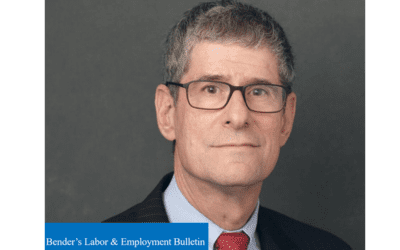A recently issued ruling from the U.S. Court of Appeals for the Sixth Circuit, Tranbarger v. Lincoln Life & Annuity Co., addresses the fundamental issue of how courts should be adjudicating Employee Retirement Income Security Act cases.[1]
Importantly, U.S. Circuit Judge John Nalbandian’s concurring opinion raised concern about the manner in which ERISA denial-of-benefit cases are litigated and invited the U.S. Supreme Court to review ERISA civil procedure, which he maintained was in conflict with the Federal Rules of Civil Procedure.
Tranbarger involved a dispute over disability benefits where both the lower court and the court of appeals ruled against the plaintiff, Vickie Tranbarger.
The U.S. District Court for the Southern District of Ohio concluded that Tranbarger failed to provide sufficient evidence to prove that she was unable to work through a six-month elimination period commencing when she initially claimed she became disabled.
The Sixth Circuit affirmed that finding, even though the court acknowledged the plaintiff’s severe pain and also noted that Tranbarger had received a favorable Social Security decision.
Judge Nalbandian filed his concurring opinion to address his concerns about the manner in which ERISA benefits litigation is conducted.
He began his concurrence by examining the text of the ERISA statute, which authorizes an aggrieved claimant to bring a civil action to seek benefits due under the terms of the plan, enforce rights under the plan terms or to clarify rights.[2]
He then pointed out that Rule 1 of the Federal Rules of Civil Procedure states that the rules apply to all civil actions brought in federal courts, except for certain types of cases enumerated in Rule 81, none of which implicate ERISA.
The concurrence thus concluded that “by negative implication, the Federal Rules should apply to ERISA civil actions,” which means the parties should be entitled to take discovery pursuant to Rule 26; move for summary judgment, if appropriate, under Rule 56; and conduct a bench trial under Rule 52. Judge Nalbandian noted that he did not include jury trials because current precedent disallows trial by jury in ERISA cases, but the circuit where he sits has recently indicated a possible willingness to reexamine that issue.[3]
The concurrence traced how ERISA litigation came to depart from civil procedure norms. In Perry v. Simplicity Engineering, the Sixth Circuit in 1990 instituted a record review regime to adjudicate ERISA benefit cases where the court would only consider the claim record and not allow the parties to submit further evidence.[4]
The stated rationale for such an approach was to prevent courts from becoming substitute plan administrations. However, as Judge Nalbandian explained, the Perry decision “failed to consider the text of the statute — the only clear indication of what Congress wanted.”[5] He added,
Section 1132 refers to “civil actions” — a term that necessarily incorporates the Federal Rules of Civil Procedure and the introduction of evidence like in any other case. But Perry chose intent over the clear text.[6]
Worsening the problem, according to Judge Nalbandian, was a 1998 Sixth Circuit case, Wilkins v. Baptist Healthcare System Inc.[7] In Wilkins, the court fashioned a special rule on how to adjudicate ERISA cases after finding that neither summary judgment under Rule 56 nor a bench trial under Rule 52 would be consistent with Perry.
On that point, Judge Nalbandian observed that though it is contrary to Rule 1,
Our approach, which eschews both Rule 56 and Rule 52, rejects the application of the Federal Rules of Civil Procedure to § 1132’s “civil action.”
According to the concurrence, the problem is magnified by a 2022 Supreme Court decision, United States v. Tsarnaev, which involved jury selection in criminal cases and held that courts were not free to fashion rules that conflict with or contravene statutes or constitutional provisions.[8] Hence, Judge Nalbandian concluded:
Bottom line, Tsarnaev prevents lower courts from creating prophylactic rules that contradict federal statutes or rules — like the Federal Rules of Civil Procedure.
Thus, Perry and Wilkins are not only inconsistent with the Federal Rules of Civil Procedure but also conflict with Tsarnaev.
The concurrence also noted a problem with the seminal 1989 Supreme Court ERISA ruling, Firestone Tire & Rubber Co. v. Bruch, which made the de novo standard of judicial review the default in the absence of a reservation of discretionary authority in the plan documents.[9]
Judge Nalbandian maintained that Firestone, by permitting two standards of judicial review in ERISA cases, implicitly endorsed “a quasi-administrative-law review regime for a ‘civil action’ under § 1132.”
In other words, instead of litigation conducted in accordance with the Federal Rules of Civil Procedure, Firestone’s invitation to the development of federal common law in adjudicating ERISA cases triggered a regime akin to how courts review administrative agency determinations.[10]
However, Judge Nalbandian also entertained a reading of Firestone that views the ruling as simply a “routine standard-of-review case.” Either way, Judge Nalbandian is inviting Supreme Court review of the entirety of ERISA litigation.
Judge Nalbandian is to be commended for pointing out the conflict between the Federal Rules of Civil Procedure and the manner in which ERISA litigation is conducted.
However, in addition to the Tsarnaev case he cited, the Supreme Court has also issued a string of rulings that define the meaning of what constitutes a “civil action.”
In every instance in which this issue has come up, the Supreme Court has steadfastly ruled that a civil action denotes a plenary proceeding in which testimony is taken and evidence presented rather than a file-review proceeding.[11]
Indeed, in Krolnik v. Prudential Ins. Co., the U.S. Court of Appeals for the Seventh Circuit in 2009 made it clear that under de novo “review” in ERISA cases, the court is not reviewing anything but is required to conduct a trial.[12]
To date, the Seventh Circuit stands alone in that regard, but Judge Nalbandian’s point that courts are not free to fashion civil procedures that do not comport with the Federal Rules of Civil Procedure should be a wakeup call to the entire federal judiciary.
Judge Nalbandian framed his concurrence with the question of how reviewing courts are to evaluate lower court ERISA rulings issued under the de novo standard, and he was correct to point out that embedded in Rule 52 is a requirement that the findings made following a bench trial “must not be set aside unless clearly erroneous.”[13] But he went even further to address how district courts adjudicate ERISA cases.
Given the evidence discussed in the court’s opinion, the plaintiff in Tranbarger would have been better served by a plenary hearing since her credibility was clearly at stake, yet it was never assessed by the trier of fact.
Had there been discovery and a trial in the district court, this case could well have had an entirely different outcome.
Mark DeBofsky is a shareholder at DeBofsky Law Ltd.
This article was first published by Law 360 on June 7, 2023.
[1] Tranbarger v. Lincoln Life & Annuity Co., 68 F.4th 311 (6th Cir. 2023).
[2] 29 U.S.C. § 1132(a)(1)(B).
[3] See, DeBofsky, “Benefits Ruling Raises Jury Trial Question for ERISA Cases,” Law360 (Sept. 24, 2021).
[4] Perry v. Simplicity Engineering, 900 F.2d 963, 966 (6th Cir. 1990).
[5] The concurrence cited two other recent Sixth Circuit cases that questioned extrastatutory ERISA procedures: Card v. Principal Life Insurance., 17 F.4th 620, 627 (6th Cir. 2021) (Murphy, J., concurring) (questioning the practice of courts “remanding” benefit claims to plan administrators) and Wallace v. Oakwood Healthcare Inc., 954 F.3d 879 (6th Cir. 2020) (Thapar, J., concurring) (questioning ERISA’s administrative exhaustion doctrine).
[6] Citing Federal Rule of Civil Procedure 1.
[7] Wilkins v. Baptist Healthcare System Inc., 150 F.3d 609 (6th Cir. 1998).
[8] United States v. Tsarnaev, 142 S. Ct. 1024, 212 L. Ed. 2d 140 (2022).
[9] Firestone Tire & Rubber Co. v. Bruch, 489 U.S. 101 (1989).
[10] See, DeBofsky, “New ERISA Rulings Diverge on Civil Procedure,” Law360 (Dec. 7, 2021); DeBofsky, “The Paradox of the Misuse of Administrative Law in ERISA Benefit Claims,” 37 John Marshall Law Review 727 (2004).
[11] See, e.g., United States v. First City National Bank, 386 U.S. 361, 368 (1967); Chandler v. Roudebush, 425 U.S. 840 (1976); and Kappos v. Hyatt, 566 U.S. 431 (2012). Also see, DeBofsky, “Benefits Ruling Shows Need for Revised ERISA Procedure,” Law360 (Dec. 1, 2022); DeBofsky, “A Critical Appraisal of the Current State of ERISA Civil Procedure – An Examination of How Courts Treat “Civil Actions” Brought Under the Employee Retirement Income Security Act,” 18 Empl. Rights & Empl. Policy Journal 203 (2014).
[12] Krolnik v. Prudential Ins. Co., 570 F.3d 841 (7th Cir. 2009).
[13] Federal Rule of Civil Procedure 52(a)(6).







